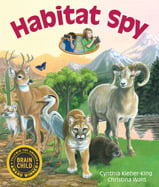Alignment to Standards for SD

| Grade | Number | Standard |
|---|---|---|
| 1 | SC-1.L.1.1. | Students are able to discover life needs of green plants. |
| 1 | SC-1.L.1.3. | Students are able to list life needs of people and other animals. |
| 1 | SC-1.L.3.1. | Students are able to relate characteristics of plants and animals that allow them to live in specific habitats. |
| 2 | SC-2.E.1.2. | geological features using maps and globes. e.g. Locate mountains, plains, valleys, and bodies of water on a globe or map. |
| 2 | SC-2.L.1.2. | classify people and animals according to similarities and differences: Classify animals by color, size, shape, body parts, gender, and offspring.Carnivore/herbirvore? |
| 2 | SC-2.L.3.1. | Students are able to describe ways that plants and animals depend on each other. (seed dispersal, nest, plants in food webs) |
| 2 | SS-2.E.1.1. | compare natural resources and human resources and how they are used. |
| 3 | SC-3.L.1.1. | identify the basic structures, functions, and needs of plants in relation to their environment: leaves, stems, roots, flowers |
| 3 | SC-3.L.1.1/2.a | Differentiate between plants and animals. |
| 3 | SC-3.L.1.2. | identify characteristic features of animals and their related functions in relation to their environment: wings/ hollow bones, webbed feet, fins |
| 3 | SC-3.L.2.1. | animals instinctively meet basic needs in their environment: baby birds know to open their mouths for food; newborn turtles know to go to water, birds know how to build nests, |
| 3 | SC-3.L.2.1.a | Give examples of basic needs (food, water, oxygen (air), shelter) |
| 3 | SC-3.L.3.1. | species depend on one another and on the environment for survival. |
| 3 | SC-3.L.3.2. | environments support a diversity of plants and animals. |
| 3 | SC-3.L.3.2.a | types of environments, e.g. deserts and what lives there |
| 4 | SC-4.L.2.1. | behavioral and structural adaptations that allow a plant or animal to survive in a particular environment. |
| 4 | SC-4.L.2.2. | a size of a population is dependent upon the available resources within its community. |
| K | SC-K.L.1.1. | Students are able to sort living from non-living things. |
| K | SC-K.L.1.1.a | Students are able to discuss the basic needs of plants and animals. |
| K | SC-K.L.1.1.b | Students are able to compare size and shape of living things. E.g. gather and sort a variety of leaves, order a variety of mammals from smallest to largest. |
| K | SC-K.P.2.1. | Students are able identify things that move. |